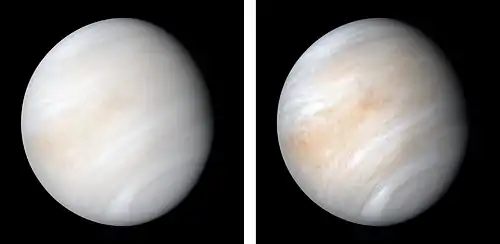C/2017 T2 (PANSTARRS)
C/2017 T2 (PANSTARRS) is an Oort cloud comet discovered on 2 October 2017 when it was 9.2 AU (1.38 billion km) from the Sun. The closest approach to Earth was on 28 December 2019 at a distance of 1.52 AU (227 million km). It came to perihelion (closest approach to the Sun) on 4 May 2020[2] when it was safe from disintegration at 1.6 AU from the Sun. (Mars is also roughly 1.6 AU from the Sun.)
 C/2017 T2 (right) passing near Messier 81 and Messier 82 on May 22, 2020 | |
| Discovery | |
|---|---|
| Discovered by | Pan-STARRS |
| Discovery date | 2 October 2017 |
| Orbital characteristics A | |
| Epoch | 2458756.5 (30 Sept 2019) |
| Observation arc | 2.68 yr |
| Orbit type | Oort cloud |
| Aphelion | ~74000 AU (inbound)[1] ~3000 AU (outbound) |
| Perihelion | 1.6150 AU |
| Eccentricity | 0.99971 |
| Orbital period | ~7 million years (inbound)[1] ~58000 years (outbound) |
| Inclination | 57.232° |
| Earth MOID | 1.2 AU (180 million km; 470 LD) |
| Jupiter MOID | 0.99 AU (148 million km; 390 LD) |
| Last perihelion | 4 May 2020[2] |
Comet C/2017 T2 (PANSTARRS) has brightened to apparent magnitude 8 and is visible with 50mm binoculars.[3][4] In early June 2020 the comet was near the magnitude 1.8 star Dubhe in Ursa Major.
JPL Horizons using an epoch 1950 orbit solution models that C/2017 T2 took millions of years to come from the Oort cloud at a distance of roughly 74,000 AU (1.2 ly).[1]
References
- JPL Horizons barycentric solution for epoch 1950 (before entering planetary region)
Goto JPL Horizons
Ephemeris Type: Orbital Elements
Center: @0 (Solar System Barycenter)
Time Span: 1950-01-01 to 2050-01-01 and Step Size: 100 years
1950-Jan-01 is "PR= 2.58E+09 / 365.25 days" = ~7 million years AND "AD= 7.38E+04" = ~74000 AU @ Aphelion - "JPL Small-Body Database Browser: C/2017 T2 (PANSTARRS)". Jet Propulsion Laboratory. Retrieved 27 May 2020.
- "Comet Observation database (COBS)". Retrieved 27 May 2020. "C/2017 T2 (PANSTARRS) plot"
- Seiichi Yoshida. "C/2017 T2 ( PanSTARRS )". Retrieved 27 May 2020.


_on_Jul_14_2020_aligned_to_stars.jpg.webp)